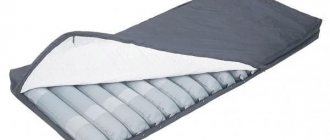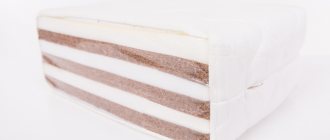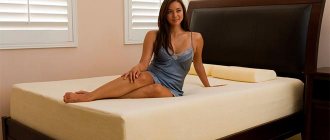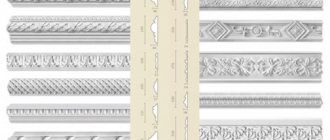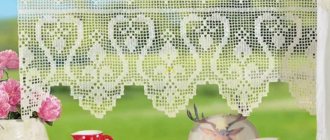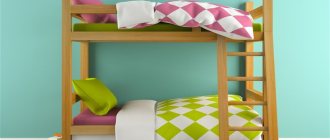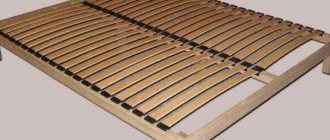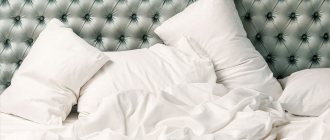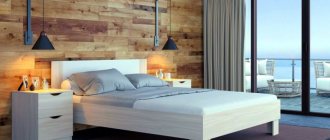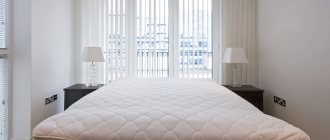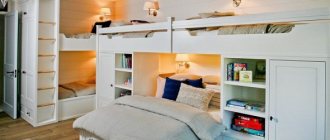Mattress size
It is important that the dimensions of the mattress (height, length and width) perfectly match the dimensions of the bed. If you are just about to purchase a bed, we recommend that you pay attention to the dimensions of the sleeping place (the inside of the bed) indicated in its description.
In this case, external dimensions do not matter. If you already have a bed, you need to measure its internal dimensions: width, length, height.
You will select a mattress based on these parameters.
p, blockquote 8,0,0,0,0 –>
After taking measurements, you will most likely get results that either correspond to standard mattress sizes or differ by a few centimeters.
p, blockquote 9,0,0,0,0 –>
Furniture and mattress manufacturers try to adhere to uniform standard sizes, so choosing the right size mattress does not cause problems. For an additional fee, which varies between 5-10%, we are ready to produce a mattress of non-standard sizes in increments of 5 cm according to your order.
Mattress length
The main rule when choosing a mattress is that the length should be 15 cm greater than your height.
p, blockquote 11,0,0,0,0 –>
Traditionally, the mattress has a length of 200 cm, which is a universal option for almost any height. If you are 175 cm tall, you will be quite comfortable on a mattress whose length is 190 cm. At the same time, there is an intermediate size of products - 195 cm.
Mattress width
It is customary to conventionally divide mattresses into single and double, focusing on width. Standard sizes of single mattresses: 80x190, 80x200, 90x190, 90x200. Standard sizes of one-and-a-half-size mattresses are 120x190, 120x200.
p, blockquote 13,0,0,0,0 –>
Double mattresses are products with a fairly large width from 140 to 200 cm (step - 20 cm).
p, blockquote 14,0,1,0,0 –>
The most popular standard mattress size for a double bed is 160x200 cm.
p, blockquote 15,0,0,0,0 –>
Expert opinion
Mikhailova Maria Vasilievna
Furniture store manager. Knows everything about comfort and interior design
Mattresses with a width of 180 and 200 cm are considered family mattresses. This is an option for families with small children. This mattress can accommodate dad, mom and baby.
p, blockquote 16,0,0,0,0 –>
Line of standard sizes of double mattresses: 140x190, 140x200, 160x190, 160x200, 180x190, 180x200, 200x200.
p, blockquote 17,0,0,0,0 –>
Mattress height
An orthopedic mattress should have a height (thickness) slightly greater than the internal height of the side of the bed. If the owner of the mattress weighs heavily, it is recommended to give preference to products with increased height.
p, blockquote 19,0,0,0,0 –>
Products with a small thickness of 2-10 cm are usually used as mattresses for sofas or mattress covers.
What influences the choice of mattress size
As for choosing the length of the mattress, there is a rule: it should be 20 cm longer than the person sleeping. There are no such strict rules regarding width, but in order for a person’s need for proper rest to be satisfied, the sleeping place definitely should not be narrow. You might also want to think about the following points.
- Favorite positions while sleeping. Those who like to sleep on their stomach and back (and even more so, spread out) may experience a lack of free space on a single mattress, but a one-and-a-half-size mattress is what they need!
- Those who are tall, accordingly, have long arms and legs. A narrow single bed will clearly not add comfort to sleep. A one-and-a-half-sleeper room is much more “interesting”!
- It has been noticed that over the years a person begins to prefer to relax in a more spacious sleeping place.
Mattress sizes for teenage beds
As noted above, children often sleep in their children's beds until adolescence, but if the child is growing quickly or you are updating the furniture by making a fresh renovation in his room, then it is important to pay attention to the teenager's growth. If he is tall and continues to grow quickly, then the length of the mattress can be 190, 195 or 200 cm if you choose standard sizes.
Width – from 80 to 120 cm, as for standard single or one-and-a-half beds.
p, blockquote 33,0,0,0,0 –>
When choosing a mattress for a child and not finding the right size in the catalog that fits a child’s bed, do not forget that you can always make an individual order. But the cost of a mattress made to individual sizes is usually slightly higher than a standard one.
p, blockquote 34,0,0,0,0 –>
Good luck with your choice and healthy sleep for your child!
p, blockquote 35,0,0,0,0 –>
Author of the article Natalya Galuzinskaya, especially for “DveMama.ru”
p, blockquote 36,0,0,0,0 –>
A one-and-a-half-size mattress is a good option
In the CIS, a model that is wider than a single bed, but narrower than a double bed, is called a one-and-a-half-bed or one-and-a-half-bed (the same applies to a bed). It is noteworthy that the concept of “lorry” is absent in European standards. Mattresses and beds with a “one-and-a-half” size are considered double economy class. In many older European homes there is not enough space to fit a standard double bed. The solution to the problem was narrow double beds.
Standard single mattress
The standard (or classic width) of one-and-a-half-size mattresses sold in the CIS countries is considered to be 120 cm. However, this size can be called a conditional standard, since manufacturers also produce other modifications, such as: 140 cm and 160 cm. Width 140 cm or 160 cm will be an excellent solution for a sleeper who prefers “freedom”, and the 160 cm option can become a temporary double bed in the economy series.
Additional sizes
A one-and-a-half bed can be a privilege not only for adults, but also for teenagers and children. A more complete list of available sizes of one-and-a-half-bed models:
- The width of mattresses for adults from the single-size series starts from 100 cm and ends at 160 cm. Includes intermediate ones - 110 cm, 120 cm, 130 cm. Length - 2 m.
- The width of children's and teenage one-and-a-half mattresses has a similar size range. Length - 190 cm.
Reference! Today, ordering a model according to individual parameters is no longer a problem. Almost all manufacturers accept such orders.
Height matters
The height of the mattress will generally depend on the type of sleeping area. If you are currently sleeping on the sofa and want to change the characteristics of the sleeping place (make it softer or harder), choose a sofa topper with a height of no more than 10 cm. If we are talking about a standard bed, the depth of the box will largely determine the choice.
Springless models are usually “thinner” than spring models. Their height, as a rule, ranges from 15 cm to 25 cm. More often - 20-22 cm. The height of spring models can reach 32 cm. Some elite models have a height of 40-50 cm.
What sizes of mattresses are there?
If we talk about the width and length of the mattress, they are usually divided into:
- Single (width from 70 to 90 cm, length up to 200 cm and above);
- One-and-a-half (width from 110 cm, length up to 200 cm and above);
- Double (width from 140 cm, length up to 200 cm and above).
p, blockquote 38,0,0,0,0 –>
Knowing the exact size of your sleeping area (mattress or bed) will help you quickly and confidently choose a quality mattress that will definitely suit you. After all, if the mattress is smaller than the sleeping area of the bed, it will move and cause discomfort during rest.
Conversely, a larger mattress will bulge and negate all orthopedic properties.
p, blockquote 39,0,0,0,0 –>
Depending on the number of people sleeping, the size of the bedroom and other individual factors, the size of the bed and mattress is selected.
p, blockquote 40,0,0,0,0 –>
Also, you should pay attention to the height of the future sleeping place.
- The standard height for spring models is 5-17 cm.
p, blockquote 41,0,0,0,0 –>
The principle of choice is based on the fact that the mattress is higher than the side of the bed.
Matching the height of the bed mattress
Very tall products will extend quite far beyond the sides of a standard bed. This, in turn, can lead to some instability of the mattress. There is also a risk that a contrast mismatch will negatively impact the overall appearance of the bed. If we talk about the suitability of the mattress for the bed, there is a general rule - the mattress should not rise above the sides of the bed by more than 15 cm (unless the design of the bed itself provides for this).
Reference! How is the height of a mattress determined? If anyone is interested in exact data, the height of a bed mattress is not the distance between the top and bottom edges. To get an accurate figure, the product should be placed on a flat, hard surface. Place a flat sheet of dense material on top. Measure the distance from the floor covering to the protruding sheet. This will be the actual height of the mattress.
Non-standard mattresses to order in St. Petersburg
We sew mattresses to order according to customer sizes in St. Petersburg.
- You indicate:
- mattress length
- mattress width
- mattress height
- Make an advance payment.
- We make a custom-made cotton wool mattress for you according to your dimensions within 7 days.
- We deliver your custom-made mattress to a pick-up point or to your home.
h3 10,0,0,0,0 –>
You can order a cotton mattress of absolutely any size!
We will be happy to make for you a custom-made children's mattress from cotton wool; we will make custom-made mattresses for a sofa, couch, ottoman or any other furniture, including a mattress for a crib.
p, blockquote 58,0,0,0,1 –>
We will make custom teak mattresses from cotton wool in non-standard sizes to suit every taste, for example, cotton wool mattresses 200x200, 180x200, 160x200, 140x200, 80x200, in general, sewing custom-made cotton mattresses of absolutely any size!
Standard sizes of children's mattresses - do they exist?
The choice of children's mattress size depends on age. We made a small “cheat sheet”:
| Age | Newborn | 1-3 years old | 3-7 years | 7-12 years | Teenager |
| Dimensions | 60Х120, 65Х125 | 70Х140, 80Х150 | 80Х160, 80Х170 | 90Х170, 90Х180 | 90Х190, 90Х200 |
It is worth noting that first a bed is purchased for the child’s age, and then a mattress is selected for this bed. If you already have a crib, focus primarily on the geometric parameters of the sleeping place in it.
It wouldn’t hurt to take a centimeter or tape measure and measure the exact length and width. This is necessary so that the mattress manufacturer can produce a perfectly suitable mattress for the crib.
Then it will neither stand on end nor dangle on the base. This is important especially for children, since their sleep is very sensitive, and any inconvenience can lead to constant awakenings.
How to choose a mattress for a child?
When buying a mattress for a child, the main thing is to choose the right firmness. The older the baby gets, the softer his sleeping place should become.
Sizes of children's mattresses
- For newborns
: 60x120 cm, 65x125 cm. - For 3-7 years
: 70x140, 70x160 cm. - From 8 years
: standard single mattresses 80 or 90 cm wide and 190 or 200 cm long.
Children's mattresses for newborns - from 0 to 2 years
Newborns
are recommended to buy very hard springless mattresses made from coconut coir. The fact is that until two or three years of age, the child’s spine is straight, the natural curve is just being formed. On a soft mattress, fragile muscles and skeleton do not receive sufficient support, and curvature is possible. Infants simply do not need innerspring mattresses. But high-quality rigid coconut springless models contribute to the correct formation of the baby’s musculoskeletal system and ensure the correct position of the body during sleep.
A child should sleep on a hard mattress until at least one and a half to two years of age.
. Next, you can select medium-hard models.
Universal double-sided children's mattresses save great money. For this age, you can choose from sides of different hardness - coconut and latex. The baby sleeps on the hard coconut side until one and a half to two years, and after that the mattress is turned over to the softer side. The mattress should be turned over only after reaching the required age and if discomfort occurs (the child falls asleep worse, tosses and turns, or wakes up frequently).
Children's mattresses for children 3 - 7 years old
Children from 3 to 7 years old
are already more demanding about the comfort of their cribs and are reluctant to fall asleep on too hard mattresses. At the same time, the curve of the spine in the cervical region is still developing, and soft models can be harmful to posture. Therefore, not very thick mattresses of medium hardness are more suitable for children aged 3-7 years. These can be either springless latex or combined (coconut + latex), as well as spring models.
It is important to consider that children 3-7 years old love to jump, tumble, and play on mattresses. Accordingly, the selected model must be resistant to such loads without loss of orthopedic properties. From this point of view, a high-quality mattress with a block of Bonnell dependent springs would be an excellent solution. Such models easily tolerate non-standard loads. Although good springless mattresses made from natural and artificial latex can be no less durable.
Children's mattresses from 7 to 12 years
For children from 7 to 12 years old,
sound sleep is no less important than for newborns. At night, the child regains strength for study and active games, so he should be absolutely comfortable on his mattress. The formation of the spine in the lumbar region continues until the age of 12, and children still need a medium-hard mattress that supports physiological processes. However, the thickness of the model should already be noticeably greater.
The best option for children 3-7 years old is a medium-hard thick springless mattress made of natural or artificial latex, as well as mattresses with a block of Bonnell dependent springs or with independent springs.
Mattresses for teenagers
Teenagers over 12 years of age are especially sensitive to stress on the spine as a result of sitting for long periods of time in class or at the computer. Therefore, at night it is advisable to let your back relax as much as possible. A mattress for a child over 12 years old should be anatomical and individually selected, quite hard, but comfortable.
Springless polyurethane foam mattresses with a thickness of 14 cm or more are ideal, as well as mattresses with independent springs that precisely adapt to the shape of the sleeper’s body and provide excellent back support. In addition to the above, when choosing a mattress, you should pay attention to environmental friendliness and hypoallergenic materials. Mattresses for newborns should be easy to dry and ventilate, allow air to pass through and retain their shape. The size of the mattress is selected according to the size of the crib. Choose a children's mattress
Why can't I order a mattress without exact measurements?
Expert opinion
Mikhailova Maria Vasilievna
Furniture store manager. Knows everything about comfort and interior design
In our country, the very old GOST 19301.3-94 applies to the geometric parameters of beds. It does not correspond to modern life and defines only 2 children's sizes: 60X120 and 60X140.
Other meanings in the understanding of GOST are non-standard. Manufacturers of cribs made a decision: since GOST does not specify a sufficient set of geometric parameters anyway, it makes sense to produce those values that are technologically convenient for them.
Therefore, each bed manufacturer has different ones. For this reason, children's mattress factories produce any size to suit the client's crib - without additional payments or extended deadlines.
How to choose a mattress for a specific bed
The ideal option (to avoid inconsistencies) is to purchase a mattress and bed from the same manufacturer. In this case, you will receive a 100% match, and quite possibly a discount. If you intend to buy products in different stores or want to purchase only a mattress, take accurate measurements.
- To accurately determine the size of the mattress, measure the parameters of the bed box from the inside.
- An old mattress may not always be an accurate measurement. As a rule, deformations during operation are inevitable.
- The mattress should be at least 2-5 cm higher than the side edges of the bed frame.
Rayton Life 5 Box bed with lifting mechanism.
How to choose a mattress for a crib next?
After you have decided on the length and width of the sleeping place, you need to choose the composition of the mattress. We have prepared a simple table for you with factors that are worth paying attention to:
| Age | Newborn | 1-3 years old | 3-7 years | 7-12 years | Teenager |
| Rigidity | hard | hard | moderately hard, medium | moderately hard, medium | moderately soft, medium |
| Filling and thickness | coconut, strutto, holofiber 6-8cm | coconut, strutto, holofiber 6-8cm + latex (natural or artificial), 6-12cm | alternating layers of latex and coconut, 10-12cm | spring block, alternating layers of latex and coconut, 14-16cm | PPU or blocks of independent springs with latex and coconut fillers, from 16 cm high |
How to choose the height of a mattress?
When we talk about a comfortable sleeping place, the first association is the mattress. We imagine the elasticity, softness of the top covering, the feel of the skin, and at the same time we rarely think about such a parameter as “ mattress height ”. However, if you think about it, it is this parameter that largely determines how comfortable you will sleep and how easy it is to get out of bed. properly selected size will ensure the most comfortable position. Before buying, you need to understand: how to choose the height of the mattress - for this you need to decide on the characteristics of the bed, your height and weight, wishes for fillers and base.
What determines the height of the mattress?
The choice of models offered on the market is unusually wide: with springs and without a spring block; mono and combined fillers - everything affects sleep and the aesthetic perception of the bed. Among other things, the sleeping place should be ergonomic, making it convenient for the owner to use it and care for the accessories.
Main types: springless and on spring blocks
There are offers without springs and based on spring blocks, which in turn are divided into dependent and independent types. Springless models are usually based on a block of polyurethane foam (polyurethane foam) or its analogues, the purpose of which is to provide shock absorption to the body during sleep. The PPU base can be supplemented with coconut coir, felt, latex. Spring mattresses are based on a single dependent block or on blocks of independent springs. The latter are usually higher in height, and bonnel-type products occupy the middle category.
- Springless mattresses are usually products up to 15 cm. Models with a height of up to 10 cm are considered low and are designed for children and teenagers.
- More than 20 cm – high mattresses with the potential to support even a large adult.
If you are considering purchasing orthopedic mattress, then pay attention to the fillers used and the hardness - the height of the mattress can vary significantly.
Fillers
One of the tasks of manufacturers is to find the optimal ratio of fillers. They should ensure that the anatomically correct position of the spine is maintained during sleep and not interfere with the microcirculation of blood and lymph in the skin and muscles. If done too softly, the curvature of the spine will be disrupted; after a hard mattress, a person will wake up “numb” and broken.
Let's look at the average values used by most manufacturers. However, remember that there are exceptions. For example, the standard range for choosing a mattress height is 8-26 cm. Thinner products no longer perform orthopedic functions. However, sometimes they make products up to 40-50 cm high.
So, let's consider the parameters of the layers in the orthopedic model:
- spring block base – on average 12-14 cm;
- felt separating the springs from the outer layers - 1 cm;
- latex (natural or artificial) – 2-3 cm;
- coconut coir slab - 1-3 cm depending on the required hardness;
- PU foam, padding polyester, quilted jacquard or knitted fabric for the top – 1-5 cm;
- 3-7 mm falls on the cover;
- the so-called “memory layer”, if present in the model, should be at least 5-6 cm.
Products are also classified as single-sided or double-sided. The latter allow you not only to vary the rigidity of the sleeping place, but are also considered more stable in use.
What height is comfortable for sleeping?
When choosing a mattress for a bed , decide which criteria you will consider first. Imagine: you are getting ready for bed, sitting on the bed, getting comfortable, falling asleep, and in the morning you wake up and get out of bed.
If you pay attention only to the width of the product , you can buy a low version that will not match your height or weight. The result will be this situation:
- you will “thump” every time you get into bed; you will have to watch your balance when sitting down;
- insufficient height will crush under you, there will not be the necessary shock absorption;
- to get out of bed, you will have to make additional efforts, and a sharp rise from a low height can lead to a drop in pressure in the morning.
It is advisable that the sleeping place be properly to really help restore strength and maintain health. When choosing, you need to focus not only on the dimensions and “hardness-softness” values.
Optimal height for a child, teenager, adult
An important criterion is the age of the person using the sleeping place. Fillers and base are selected taking into account age needs and health status. A properly selected mattress height will allow a child to form correct posture, relieve the back muscles of an adult and help an elderly person to rest comfortably and wake up refreshed.
Babies 0-3 years old
Pediatricians recommend using low mattresses based on coconut coir. For a fragile child's spine, a harder base is important in order to form correct posture and strengthen the muscular corset of the back. A sleeping place that is too soft, combined with a high pillow, can easily cause the development of scoliosis. The height of the mattress is on average 8 cm, sometimes less.
Children 4-16 years old
Here the height of the product grows with the child. The sleeping accessory for kindergarten and primary schoolchildren varies from 8 to 10 cm, 11-15 cm for models for teenagers. A prerequisite for a children's mattress will be high rigidity, as the body grows and the spine requires additional formative support.
Adults
Here the choice will depend not only on preferences, height and weight, but also on the level of muscle tone. Active, athletic men and women will prefer a firmer solution, while people with average and weakened muscle tone will choose softer mattresses. The height will depend on the springs and fillers used. For example, the presence of a thick layer of coir will make even a high mattress hard.
Aged people
With age, it becomes more difficult to sleep on a hard surface, as the percentage composition of muscle mass and fat changes, and problems with joints begin. Pensioners and older people prefer models with great softness sleeping places
Regardless of age, the choice will be individual, based on the person’s height, weight and the height of the bed on which the mattress is planned to be placed. If all the criteria are met correctly, the bed will be comfortable, and the overall appearance of the bed will harmoniously fit into the interior of the bedroom.
The optimal bed height is when your knees bend at a right angle when sitting on the bed. If the bed is higher, you will not reach the floor with your feet, there is a risk of losing your balance when you are asleep and twisting your ankle. If the bed is too low, it is much more difficult to get up, which is especially critical for older people.
Tips for choosing mattress height
When purchasing, proceed from the configuration of the bed for which the product is intended. The height of the sides is an important criterion that directly affects the ease of use of the berth. There may be no sides - regardless of the height of the mattress, take a model with Velcro fasteners so that the product does not slide off the logs.
- If the sides are 5 cm, then the optimal height will be no more than 20 cm.
- If the board is 6-10 cm, choose models 20-22 cm.
- A deep bed for a mattress up to 15 cm is a reason to choose products with a height of 23 cm.
The second criterion that must be taken into account is the number of layers of filler. We remember that mattresses are double-sided, which means that the layers of latex, coir, and polyurethane foam will be duplicated on both sides. Look carefully at the springs used by the manufacturer - not only the height of the chosen mattress depend but also the quality of shock absorption of the sleeping place. Some unscrupulous manufacturers use lowered springs, trying to compensate for the height with fillers. Such a substitution makes the mattress high, but uncomfortable, and orthopedic properties are impaired.
The best option when choosing a product is the opportunity to personally try the mattress on a demo sample. If possible, visit the showroom and try the product in practice. Sit down, do not hesitate to lie down, the sleeping place should best suit its tasks and your preferences. Remember: a third of our life passes in a dream, therefore it is impossible to treat this issue negligently.
Sizes of children's mattresses for beds for children: table
Complete rest for a body tired during the day is possible only in the most relaxed position. Only a truly high-quality mattress can provide this level of comfort.
Long gone are the days of identical cotton mattresses with the obligatory strings. The range of modern textile industry successfully offers more and more new, fundamentally new models of orthopedic mattresses.
Such a sleeping surface will allow the body to completely relax, relieving the strain on each muscle. When choosing such a sleeping miracle, you need to follow simple rules, especially paying attention to the material used and the optimal size of the mattresses.
Types of fillers
When studying the issue of choosing a children's mattress for a crib, you need to pay more attention to the filling option of the product. Pediatric experts say that in the early stages of a baby's development, the skeletal framework is formed and strengthened.
To avoid problems in the future, you need to choose a really good mattress; it’s better to spend more than once than to regret it later.
It is recommended to select filler from materials such as:
- Coconut coir. This is a completely natural product that is obtained by processing coconut fiber. The filler is quite hard and is able to create the necessary conditions for the flow of air and moisture. Does not absorb unpleasant odors, does not absorb water well. If we talk about expensive stuffing, then natural impregnation is used for production. Cheap models may use substances that are unsafe for children.
- Latex. It is also a natural element obtained from the sap of the Hevea plant. In some situations it can cause an allergic reaction; it is quite elastic, but softer than coir. The best solution would be a product that combines coconut and latex.
- Polyurethane foam. This is a tougher version of foam rubber. It can last a very long time, is safe, and provides the necessary passage of air and moisture. It lights up poorly and is used in the manufacture of orthopedic models.
- Struttofiber. This element does not cause allergies; it is produced using the press of natural and synthetic components. Excellent for use in winter - retains heat very well.
On video: how to choose a children's mattress.
Briefly about fillers
The range of modern fillers is amazing and continues to increase. Manufacturers are developing new technologies and combining existing ones. It is possible to choose between completely natural, blended and artificial fillers.
- Latex. Natural latex is Hevea juice “prepared” using a special technology. Very elastic and elastic material. It has high orthopedic characteristics. However, 100% latex as a filler is expensive. Artificial latex (PPU with a certain percentage of 100% latex in the composition) is inferior to its natural counterpart (less elastic, less durable), but is much cheaper.
- Coconut fiber (coir). Natural material with high rigidity.
- PPU (polyurethane foam). Improved brands of foam rubber provide fairly high orthopedic support. May vary in level of hardness (depending on production technology).
- Memory. Foam rubber, which, unlike polyurethane foam, does not create a springing effect. Instead, it gently adapts to the anatomical features of the human body, as if enveloping it. It has a fairly high cost.
Orthopedic mattresses for babies
Perhaps this is the best option for a newborn baby. The optimal choice would be a springless orthopedic model. Most quality products are equipped with one or more fillers. It happens that pressed horsehair is used as stuffing.
The manufacturing process uses a pattern of alternating soft and hard layers, which allows for better rigidity and elasticity of the sleeping bag. In infancy, such a mattress is placed on one side so that the child sleeps on the hard side. Then, when it grows, the product can be turned over to the soft side.
Main varieties
As already noted, it is not only compliance with the dimensions of the bed that determines the quality of the base for the bed. This product is available in several forms:
- orthopedic;
- spring;
- springless;
- hypoallergenic;
- with coconut filling.
When choosing between types of mattresses for children's beds, it is necessary to take into account both the age and characteristics of the child's body. In particular, for newborns it is recommended to purchase springless products with a hypoallergenic coating.
The quality of children's sleep depends on the characteristics of the bed base. In addition, these parameters influence the development of the child in the first years of life. Incorrectly selected bedding can lead to curvature of the spine, which in the future will require complex physiotherapeutic procedures.
Spring
Such models are also divided into several types. For children, it is recommended to buy mattresses with an interdependent spring block. You can check this nuance without removing the coating. To do this, press on one edge of the mattress. If the product is lifted from the second side, then each spring under the coating is connected to the others.
Buying such bedding is justified for teenagers. Despite the fact that spring models do not cause significant harm to the spine, it is not recommended to place these products in the beds of young children.
This recommendation is due to the fact that a child can move out of bed due to the fact that when pressure is applied, one edge of the mattress rises. There are also models that contain several springs, combined into separate blocks.
These products do not have the above disadvantage.
Springless
Springless models are divided into the following types:
- Latex. They are considered the best option for a children's bed. Latex models evenly redistribute the load on the spine, preventing sweating and the appearance of harmful organisms such as dust mites.
- Polyurethane foam. This synthetic material is based on natural ingredients. Polyurethane foam mattresses are characterized by good elasticity and ensure the correct position of the spine during sleep. Models of this type are hypoallergenic.
- Made from viscoelastic foam. Microporous material is able to “remember” the anatomical features of a person, thereby providing comfortable rest.
Some mattress models are equipped with additional layers made of different materials: biofoam (not recommended for children as it emits odors), flexfiber (able to retain its original shape) and spunbond. The latter is more often used in bedding with springs.
Orthopedic
Orthopedic mattresses are available with both springs and other fillers. In the latter case, additional layers are provided that redistribute the load along the entire length of the bed. Orthopedic mattresses are recommended for children of all ages. Such models are able to maintain the shape of the back during sleep without sagging over time.
Orthopedic mattresses are required for children who have been diagnosed with disorders in the development of the spine. Models without a spring block are considered optimal. This is explained by the fact that such products last up to 15 years.
Coconut
Coconut filler is breathable, does not collect dust or moisture, and does not cause an allergic reaction. The material is characterized by increased rigidity. Due to this, coconut filler is used in the manufacture of orthopedic mattresses.
Measurement systems - domestic and Eurosize
This information is needed for those who are planning to purchase a mattress or bed from a foreign manufacturer. This is a crucial moment, especially in the case when the bed and mattress “come from” different countries (with different measurement systems).
Metric measuring system . The most common in the CIS countries and in Europe (France, Italy, Germany). It makes calculations in the familiar millimeters, centimeters and meters.
English measuring system . English-speaking manufacturing countries - the USA, Great Britain, Australia - use inches and pounds as units of measurement. Converting the parameters to centimeters shows that matching a European mattress to an English base (or vice versa) is quite difficult.
Important! The mattress and bed should be one unit. A smaller product will fidget and constantly move inside the bed frame. A mattress whose dimensions are larger (than that of a bed box) has a high risk of deformation. Attempts to squeeze it in will lead to the formation of defects on the sleeping surface, which will be noticeable to the sleeper. The mattress will not be able to perform orthopedic functions.
